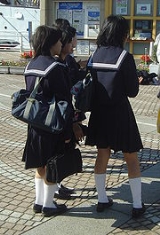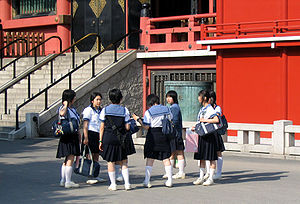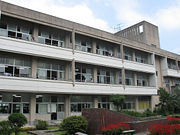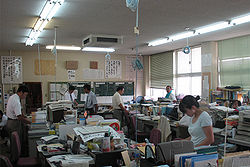
Secondary education in Japan
Encyclopedia


Middle school
Middle School and Junior High School are levels of schooling between elementary and high schools. Most school systems use one term or the other, not both. The terms are not interchangeable...
s (中学 chūgaku) which cover the seventh through ninth grades, and high school
High school
High school is a term used in parts of the English speaking world to describe institutions which provide all or part of secondary education. The term is often incorporated into the name of such institutions....
s (高等学校 kōtōgakkō, abbreviated to 高校 kōkō) which mostly cover grades ten through twelve. Attendance in upper secondary school
Secondary school
Secondary school is a term used to describe an educational institution where the final stage of schooling, known as secondary education and usually compulsory up to a specified age, takes place...
is not compulsory, but most students do attend.
Most Japanese upper secondary schools have complicated admissions procedures, similar to university
University
A university is an institution of higher education and research, which grants academic degrees in a variety of subjects. A university is an organisation that provides both undergraduate education and postgraduate education...
admissions in other countries. Some of the top high schools, however, graduate their students directly into the top universities, such as the University of Tokyo
University of Tokyo
, abbreviated as , is a major research university located in Tokyo, Japan. The University has 10 faculties with a total of around 30,000 students, 2,100 of whom are foreign. Its five campuses are in Hongō, Komaba, Kashiwa, Shirokane and Nakano. It is considered to be the most prestigious university...
. Students who do not plan to attend university are generally tracked into vocational high schools: very few lower secondary school graduates forgo upper secondary school entirely, although they are free to do so if they wish.
In Japan, the School Education Law was revised in 1998, and secondary schools were newly recognized. Education in these schools combines that of middle and high schools, without a clear break.
A further revision to the law was carried out on 15 December 2006. The revised law leaves the structure of schooling basically the same but includes new emphases on respect for Japanese culture (Article 2.5), school discipline
Discipline
In its original sense, discipline is referred to systematic instruction given to disciples to train them as students in a craft or trade, or to follow a particular code of conduct or "order". Often, the phrase "to discipline" carries a negative connotation. This is because enforcement of order –...
(Article 6.2), and parent
Parent
A parent is a caretaker of the offspring in their own species. In humans, a parent is of a child . Children can have one or more parents, but they must have two biological parents. Biological parents consist of the male who sired the child and the female who gave birth to the child...
al responsibility
Moral responsibility
Moral responsibility usually refers to the idea that a person has moral obligations in certain situations. Disobeying moral obligations, then, becomes grounds for justified punishment. Deciding what justifies punishment, if anything, is a principle concern of ethics.People who have moral...
(Article 10).
Middle school

Like most elementary schools, most middle schools in the 1980s were public schools and government funded, but 5% were private schools. Private schools cost about 558,592 (Yen) (US$3,989) per student in 1988, about four times more than the 130,828 yen (US$934) that the ministry estimated as the cost for students enrolled in public middle schools.
The teaching force in lower-secondary schools is two-thirds male. Schools are headed by principals, 99% of whom were men in 1988. Teachers often majored in the subjects they taught, and more than 80% graduated from a four-year college. Classes are large, with thirty-eight students per class on average, and each class is assigned a homeroom teacher who doubles as counselor
School counselor
A school counselor is a counselor and an educator who works in elementary, middle, and high schools to provide academic, career, college access, and personal/social competencies to K-12 students...
. Unlike Elementary
Elementary school
An elementary school or primary school is an institution where children receive the first stage of compulsory education known as elementary or primary education. Elementary school is the preferred term in some countries, particularly those in North America, where the terms grade school and grammar...
students, middle school students have different teachers for different subjects. The teacher, however, rather than the students, moves to a new room for each fifty-minute period.
Instruction tends to rely on the lecture
Lecture
thumb|A lecture on [[linear algebra]] at the [[Helsinki University of Technology]]A lecture is an oral presentation intended to present information or teach people about a particular subject, for example by a university or college teacher. Lectures are used to convey critical information, history,...
method. Teachers also use other media, such as television
Television
Television is a telecommunication medium for transmitting and receiving moving images that can be monochrome or colored, with accompanying sound...
and radio
Radio
Radio is the transmission of signals through free space by modulation of electromagnetic waves with frequencies below those of visible light. Electromagnetic radiation travels by means of oscillating electromagnetic fields that pass through the air and the vacuum of space...
, and there is some laboratory
Laboratory
A laboratory is a facility that provides controlled conditions in which scientific research, experiments, and measurement may be performed. The title of laboratory is also used for certain other facilities where the processes or equipment used are similar to those in scientific laboratories...
work. By 1989 about 45% of all public lower-secondary schools had computers, including schools that used them only for administrative purposes. Classroom organization is still based on small work groups, although no longer for reasons of discipline. Students are expected to have mastered daily routines and acceptable behavior.
All course contents are specified in the Course of Study for Lower-Secondary Schools
Curriculum
See also Syllabus.In formal education, a curriculum is the set of courses, and their content, offered at a school or university. As an idea, curriculum stems from the Latin word for race course, referring to the course of deeds and experiences through which children grow to become mature adults...
. Some subjects, such as Japanese language
Japanese language
is a language spoken by over 130 million people in Japan and in Japanese emigrant communities. It is a member of the Japonic language family, which has a number of proposed relationships with other languages, none of which has gained wide acceptance among historical linguists .Japanese is an...
and mathematics
Mathematics
Mathematics is the study of quantity, space, structure, and change. Mathematicians seek out patterns and formulate new conjectures. Mathematicians resolve the truth or falsity of conjectures by mathematical proofs, which are arguments sufficient to convince other mathematicians of their validity...
, are coordinated with the elementary curriculum
Curriculum
See also Syllabus.In formal education, a curriculum is the set of courses, and their content, offered at a school or university. As an idea, curriculum stems from the Latin word for race course, referring to the course of deeds and experiences through which children grow to become mature adults...
. The curriculum covers Japanese language, social studies, mathematics, science, music, fine arts, health, and physical education. All students also are exposed to either industrial arts or homemaking. Moral
Morality
Morality is the differentiation among intentions, decisions, and actions between those that are good and bad . A moral code is a system of morality and a moral is any one practice or teaching within a moral code...
education and special activities continue to receive attention. In science, students may take courses 'emphasizing the safety and necessity of nuclear power plants, with curricula written by government bureaucrats rather than teachers'http://www.tnr.com/article/world/85463/japan-nuclear-power-regulation
Students also attend mandatory club meetings during school hours, and many also participate in after-school clubs. Sports clubs, such as Yakyu (baseball) tend to be especially popular among boys, while wind bands are the most popular club among girl students. Some middle schools also encourage students to take ability tests such as the STEP Eiken
STEP EIKEN
— informally, ; often called STEP EIKEN or the STEP Test — is an English language test conducted by a Japanese non-profit organization, the Society for Testing English Proficiency, Inc. , and backed by the Japanese Ministry of Education, Culture, Sports, Science and Technology .-Format...
for English or the Kanji kentei
Kanji kentei
The , also known as , or , is a test of kanji ability.There are 12 levels with level 10 being the easiest and level 1 the most difficult. The test examines ability to read and write kanji, to understand their meanings and use them correctly in sentences, and to identify correct stroke order...
for Japanese.
The ministry recognizes a need to improve the teaching of all foreign languages, especially English. To improve instruction in spoken English
English language
English is a West Germanic language that arose in the Anglo-Saxon kingdoms of England and spread into what was to become south-east Scotland under the influence of the Anglian medieval kingdom of Northumbria...
, the government invites many young native speakers of English to Japan to serve as assistants to school boards and prefectures
Prefectures of Japan
The prefectures of Japan are the country's 47 subnational jurisdictions: one "metropolis" , Tokyo; one "circuit" , Hokkaidō; two urban prefectures , Osaka and Kyoto; and 43 other prefectures . In Japanese, they are commonly referred to as...
under its Japan Exchange and Teaching Program
JET Programme
or is a Japanese government initiative that brings college graduates—mostly native speakers of English—to Japan as Assistant Language Teachers and Sports Education Advisors in Japanese kindergartens, elementary, junior high and high schools, or as Coordinators for International Relations in...
. By 2005 participants numbered over 6,000. In the last few years, several school boards in Japan have relied on ALTs (Assistant Language Teacher
Assistant Language Teacher
Assistant Language Teacher is a term that was created by the Japanese Ministry of Education at the time of the creation of the JET Programme as a translation of the term 外国語指導助手 or literally "foreign language instruction assistant." The terms AET , ELT and NESA Assistant Language Teacher (ALT)...
) from private dispatch companies.

Citizenship
Citizenship is the state of being a citizen of a particular social, political, national, or human resource community. Citizenship status, under social contract theory, carries with it both rights and responsibilities...
. In some measure, this means increased emphasis on Japanese history and culture, as well as understanding Japan as a nation and its relationships with other nations of the world. The course of study also increased elective hours, recommending that electives be chosen in light of individual student differences and with an eye toward diversification.
Two problems of great concern to educators and citizens began to appear at the lower-secondary level in the 1980s: bullying, which remains a major problem , and the school-refusal syndrome
School refusal
School refusal is a term originally used in the United Kingdom to describe refusal to attend school, due to emotional distress. School refusal differs from truancy in that children with school refusal feel anxiety or fear towards school, whereas truant children generally have no feelings of fear...
(toko kyohi—manifested by a student's excessive absenteeism
Truancy
Truancy is any intentional unauthorized absence from compulsory schooling. The term typically describes absences caused by students of their own free will, and usually does not refer to legitimate "excused" absences, such as ones related to medical conditions...
), which was on the rise. In 2008, there were 42,754 incidents of problematic behavior in middle schools, according to a government survey.(The Daily Yomiuri 2/12/2009)
Experts disagreed over the specific causes of these phenomena, but there is general agreement that the system offers little individualized or specialized assistance, thus contributing to disaffection among those who can not conform to its demands or who are otherwise experiencing difficulties. Another problem concerns Japanese children returning from abroad. These students, particularly if they have been overseas for extended periods, often need help not only in reading and writing but also in adjusting to rigid classroom demands. Even making the adjustment does not guarantee acceptance: besides having acquired a foreign language, many of these students have also acquired foreign customs of speech, dress, and behavior that mark them as different.
High school
Even though upper-secondary school is not compulsory in Japan, 94% of all lower-secondary school graduates entered upper secondary schools in 1989. Private upper-secondary schools account for about 24% of all upper-secondary schools. The Ministry of Education estimated that annual family expenses for the education of a child in a public upper-secondary school were about ¥Japanese yen
The is the official currency of Japan. It is the third most traded currency in the foreign exchange market after the United States dollar and the euro. It is also widely used as a reserve currency after the U.S. dollar, the euro and the pound sterling...
300,000 (US$2,142) in both 1986 and 1987 and that private upper-secondary schools were about twice as expensive. However, starting April 2010, due to the "Act on Free Tuition Fee at Public High Schools and High School Enrollment Support Fund," passed March 31, 2010 and enacted April 1, 2010, standard Japanese public high school education is now tuition-free.
All upper-secondary schools, public and private, are informally ranked, based on their success in placing graduates in freshman classes of the most prestigious universities. In the 1980s, private upper-secondary schools occupied the highest levels of this hierarchy, and there was substantial pressure to do well in the entrance examination
Entrance examination
An entrance examination is an examination that many educational institutions use to select students for admission. These exams may be administered at any level of education, from primary to higher education, although they are more common at higher levels....
s that determined the upper-secondary school a child entered. Admission also depends on the scholastic record and performance evaluation from lower-secondary school, but the examination results largely determine school entrance. Students are closely counseled in lower-secondary school, so that they will be relatively assured of a place in the schools to which they apply.
The most common type of upper-secondary schools has a full-time, general program that offered academic courses for students preparing for higher education
Higher education in Japan
- University entrance :University entrance is based largely on the scores that students achieved in entrance examinations . Private institutions accounted for nearly 80% of all university enrollments in 1991, but with a few exceptions, the public national universities are the most highly regarded...
and also technical and vocational courses for students expecting to find employment after graduation. More than 70% of upper-secondary school students were enrolled in the general academic program in the late 1980s. A small number of schools offer part-time or evening courses or correspondence education.
Curriculum
See also: Japanese history textbook controversiesJapanese history textbook controversies
Japanese history textbook controversies refers to controversial content in government-approved history textbooks used in the secondary education of Japan...
The first-year programs for students in both academic and commercial courses are similar. They include basic academic courses, such as Japanese language
Japanese language
is a language spoken by over 130 million people in Japan and in Japanese emigrant communities. It is a member of the Japonic language family, which has a number of proposed relationships with other languages, none of which has gained wide acceptance among historical linguists .Japanese is an...
, English
English language
English is a West Germanic language that arose in the Anglo-Saxon kingdoms of England and spread into what was to become south-east Scotland under the influence of the Anglian medieval kingdom of Northumbria...
, mathematics
Mathematics
Mathematics is the study of quantity, space, structure, and change. Mathematicians seek out patterns and formulate new conjectures. Mathematicians resolve the truth or falsity of conjectures by mathematical proofs, which are arguments sufficient to convince other mathematicians of their validity...
, and science
Science
Science is a systematic enterprise that builds and organizes knowledge in the form of testable explanations and predictions about the universe...
. In upper-secondary school, differences in ability are first publicly acknowledged, and course content and course selection are far more individualized in the second year. However, there is a core of academic material throughout all programs. Vocational-technical programs includes several hundred specialized courses, such as information processing, navigation
Navigation
Navigation is the process of monitoring and controlling the movement of a craft or vehicle from one place to another. It is also the term of art used for the specialized knowledge used by navigators to perform navigation tasks...
, fish farming, business English, and ceramics
Japanese pottery
Japanese pottery and porcelain , one of the country's oldest art forms, dates back to the Neolithic period...
. Business and industrial courses are the most popular, accounting for 72% of all students in full-time vocational programs in 1989.
The upper-secondary curriculum also underwent thorough revision; in 1989 a new Course of Study for Upper-Secondary Schools was announced that was to be phased in beginning with the tenth grade in 1994, followed by the eleventh grade in 1995 and the twelfth grade in 1996. Among noteworthy changes is the requirement that both male and female students take a course in home economics
Home Economics
Home economics is the profession and field of study that deals with the economics and management of the home and community...
. The government is concerned with instilling in all students an awareness of the importance of family life
Japanese family
The family in Japan is called “Kazoku” in Japanese. It is basically composed of a couple as is the family in other societies. The Japanese family is based on the line of descent...
, the various roles and responsibilities of family members, the concept of cooperation within the family, and the role of the family in society. The family continues to be an extremely important part of the social infrastructure, and the ministry clearly is interested in maintaining family stability within a changing society. Another change of note was the division of the old social studies
Social studies
Social studies is the "integrated study of the social sciences and humanities to promote civic competence," as defined by the American National Council for the Social Studies...
course into history
History
History is the discovery, collection, organization, and presentation of information about past events. History can also mean the period of time after writing was invented. Scholars who write about history are called historians...
, geography
Geography
Geography is the science that studies the lands, features, inhabitants, and phenomena of Earth. A literal translation would be "to describe or write about the Earth". The first person to use the word "geography" was Eratosthenes...
, and civics
Civics
Civics is the study of rights and duties of citizenship. In other words, it is the study of government with attention to the role of citizens ― as opposed to external factors ― in the operation and oversight of government....
courses, not to mention, this has nothing about subject expectations.

